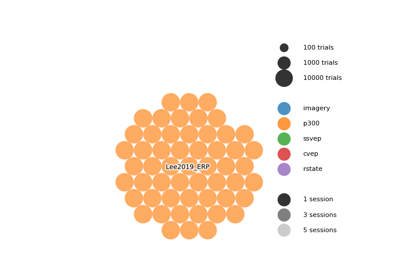moabb.datasets.Lee2019_ERP#
- class moabb.datasets.Lee2019_ERP(train_run=True, test_run=None, resting_state=False, sessions=(1, 2))[source]#
BMI/OpenBMI dataset for P300.
PapersWithCode leaderboard: https://paperswithcode.com/dataset/lee2019-erp-moabb-1
Dataset summary
#Subj
54
#Chan
62
#Trials / class
6900 NT / 1380 T
Trials length
1 s
Freq
1000 Hz
#Sessions
2
Dataset from Lee et al 2019 [1].
Dataset Description
EEG signals were recorded with a sampling rate of 1,000 Hz and collected with 62 Ag/AgCl electrodes. The EEG amplifier used in the experiment was a BrainAmp (Brain Products; Munich, Germany). The channels were nasion-referenced and grounded to electrode AFz. Additionally, an EMG electrode recorded from each flexor digitorum profundus muscle with the olecranon used as reference. The EEG/EMG channel configuration and indexing numbers are described in Fig. 1. The impedances of the EEG electrodes were maintained below 10 k during the entire experiment.
ERP paradigm The interface layout of the speller followed the typical design of a row-column speller. The six rows and six columns were configured with 36 symbols (A to Z, 1 to 9, and _). Each symbol was presented equally spaced. To enhance the signal quality, two additional settings were incorporated into the original row-column speller design, namely, random-set presentation and face stimuli. These additional settings help to elicit stronger ERP responses by minimizing adjacency distraction errors and by presenting a familiar face image. The stimulus-time interval was set to 80 ms, and the inter-stimulus interval (ISI) to 135 ms. A single iteration of stimulus presentation in all rows and columns was considered a sequence. Therefore, one sequence consisted of 12 stimulus flashes. A maximum of five sequences (i.e., 60 flashes) was allotted without prolonged inter-sequence intervals for each target character. After the end of five sequences, 4.5 s were given to the user for identifying, locating, and gazing at the next target character. The participant was instructed to attend to the target symbol by counting the number of times each target character had been flashed. In the training session, subjects were asked to copy-spell a given sentence, “NEURAL NETWORKS AND DEEP LEARNING” (33 characters including spaces) by gazing at the target character on the screen. The training session was performed in the offline condition, and no feedback was provided to the subject during the EEG recording. In the test session, subjects were instructed to copy-spell “PATTERN RECOGNITION MACHINE LEARNING” (36 characters including spaces), and the real-time EEG data were analyzed based on the classifier that was calculated from the training session data. The selected character from the subject’s current EEG data was displayed in the top left area of the screen at the end of the presentation (i.e., after five sequences). Per participant, the collected EEG data for the ERP experiment consisted of 1,980 and 2,160 trials (samples) for training and test phase, respectively.
- Parameters:
train_run (bool (default True)) – if True, return runs corresponding to the training/offline phase (see paper).
test_run (bool (default: False for MI and SSVEP paradigms, True for ERP)) – if True, return runs corresponding to the test/online phase (see paper). Beware that test_run for MI and SSVEP do not have labels associated with trials: these runs could not be used in classification tasks.
resting_state (bool (default False)) – if True, return runs corresponding to the resting phases before and after recordings (see paper).
sessions (list of int (default [1,2])) – the list of the sessions to load (2 available).
References
[1]Lee, M. H., Kwon, O. Y., Kim, Y. J., Kim, H. K., Lee, Y. E., Williamson, J., … Lee, S. W. (2019). EEG dataset and OpenBMI toolbox for three BCI paradigms: An investigation into BCI illiteracy. GigaScience, 8(5), 1–16. https://doi.org/10.1093/gigascience/giz002
